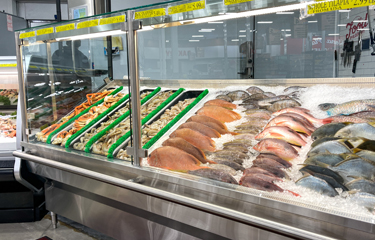Rising seafood prices and consumer concerns about overall inflation in the U.S. continued to harm fresh seafood sales in April, according to new data.
However, frozen seafood sales rose 2.8 percent and shelf-stable seafood sales jumped 9.6 percent for the month, compared to April 2021, according to IRI and 210 Analytics.
Fresh seafood prices jumped an average of 13.5 percent per unit in April, higher than the 12.1 percent they experienced increase in March. The average price for finfish jumped to over USD 10.00 (EUR 9.50) per unit – a spike of 20.9 percent – while fresh shellfish prices rose 2.3 percent, IRI and 210 Analytics found.
Potentially in response, fresh seafood sales plummeted 11.8 percent to USD 493 million (EUR 468 million) in April.
While dollar sales remained above pre-pandemic levels, sales volumes are trailing 2019 levels, 210 Analytics Principal Anne-Marie Roerink said.
“This is especially true for shellfish, for which pounds are 11.6 percent behind April 2019 levels,” she said.
Roerink said she expects the prices of seafood to spike further amid Russian sanctions, with particular impact on crab, cod, and Alaska pollock. The war in Ukraine, renewed COVID lockdowns in China, record inflation, labor shortages, and supply chain challenges “will have a continued effect on food and frozen food sales in the months to come,” she said.
Despite higher prices, frozen seafood recorded 2.8 percent higher year-over-year sales. Frozen fish sales jumped 7.9 percent and frozen raw shrimp sales were up 3.2 percent. However, frozen cooked seafood items dropped 6.2 percent in April.
Frozen seafood remained the biggest seller of all frozen animal proteins, though it had the lowest growth, with a 5.3 percent decline in unit sales, Roerink said.
Ambient seafood realized a 9.6 percent hike in dollar sales to USD 223 million (EUR 212 million) and a 6.5 percent rise in volume.
“Frozen and canned have two advantages over fresh seafood during inflationary times like these,” Roerink told SeafoodSource in April. “The number-one advantage is shelf-life – whereas fresh seafood needs to be used or frozen within a few days of purchase, frozen and canned seafood have little to no waste.”
The other primary advantage is price per unit and price perceptions, Roerink said.
“Many consumers believe that frozen is cheaper than fresh. In some cases, this is correct; in other cases, there really isn’t much of a difference, but perception is reality,” Roerink said. “More importantly, frozen and canned have a more favorable unit price, which underscores the idea of it being more price-advantageous. People may decide on a tuna salad sandwich instead of a fresh or frozen cod filet, for instance.”
Inflation is hitting nearly all categories in the grocery store, as 75 percent of consumers say they have less confidence to spend as inflation hits a 40-year high, according to a new First Insight report.
Notably, 37 percent of consumers say they will reduce their consumption of meat and seafood in response to rising prices, according to First Insight. Meanwhile, 41 percent will cut back on name-brand product purchases, 34 percent will reduce their snack-food purchases, 29 percent will reduce purchases of alcohol and spirits, and 26 percent will buy fewer organic products.
Nearly all (97 percent) of Americans are reprioritizing how they spend in order to afford their top four most-critical purchases: groceries (56 percent), gasoline (43 percent), housing costs (29 percent), and healthcare (18 percent), First Insight said.
Thirty-five percent of consumers say they are cutting back on restaurant spending, according to IRI’s April consumer survey.
However, that may not automatically translate into fewer restaurant visits, Roerink said. The consumer estimated share of meals prepared at home dropped slightly to 78.8 percent.
“This points to consumers visiting restaurants a bit more than during December through February, but they are finding ways to reduce their spending,” she said.
IRI found 91 percent of U.S. consumers expect to cook from scratch as much (72 percent) or more often (19 percent) as last year, according to IRI.
“Another opportunity is renewed in-person socializing with friends and family, with 15 percent expecting to entertain more,” Roerink said.
Photo courtesy of Joni Hanebutt/Shutterstock







